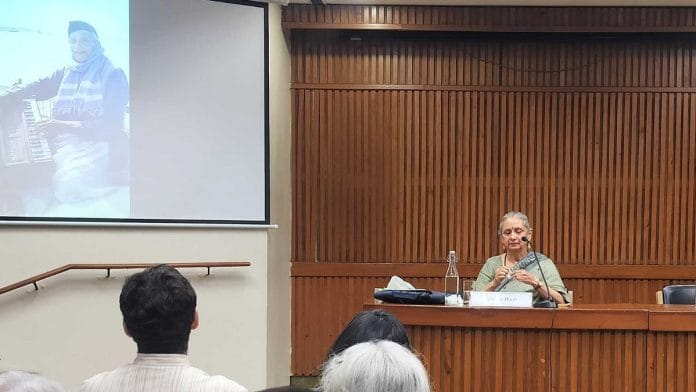New Delhi: Even as she was struggling to breathe because of a terrible allergy, Hindustani classical singer Vidya Rao gave a two-hour-long lecture to singers, students, music appreciators on how to find bhav in Thumri, a light classical music form.
But she wasn’t alone in the lecture at the India International Centre. Rao leaned on the wisdom of some of the greats of Hindustani classical music, including Naina Devi, Pandit Mahadev Mishra, Shipra Bose, and Birju Maharaj.
Throughout the lecture, The Many Routes to Bhav in Thumri, Rao played bits of the performances of the singers and urged the audience to find emotion, while noting the voice modulations, dialogue, vocatives.
An illustrated lecture
Rao began the talk with a simple declaration: “You cannot perform Thumri without bhav (emotion), if you don’t have it then might as well pack up. But bringing bhav is an act of will, it is something you can do and learn.”
In the succeeding couple of hours, the singer would touch upon emotion, technique, wonder, voice, theory, and even lean on the skill of a listener to illustrate how emotions are to be infused in a song. But she warned her audience: bhav is not something which can be pinpointed in a song, and that adds to the beauty of it.
“People say you cannot learn it (emoting), but I feel it’s unfair, there must be something you can learn in it. And I think it’s fair too… you must struggle a bit to master something,” she said.
Rao advised the audience to follow other disciplines and learn from their pedagogy, and work out how that skill could be absorbed into singing styles. “The voice has to be inhabited by different characters, and it has to understand how the characters would express themselves”.
Thumri is closely associated with Kathak. But with time, Rao revealed, the differentiation between the two disciplines got clearer. And yet, a narrative, and a psychological route connecting the two disciplines remain.
Also read: Russian ballet meets Kathak in Delhi. It’s a confluence of traditions, art, music
The performances
The first performance Rao played was of her guru, Naina Devi. Through Devi’s singing, she illustrated the importance of vocatives, or thob akshar, in a Thumri. Vocatives, she said, can be used to address and bring the audience into the performance.
In the next video, Pandit Mahadev Mishra came alive on the screen. Mishra used the vocative ‘ho’ repeatedly in ‘vyakul bhayee’—he was singing to god. Rao said it was his way of inviting the audience and asking them to sit and listen.
“Just this slight modulation in the voice has to be done with so much economy otherwise it becomes horrible,” she said.
Rao emphasises that singers need not look for a big trick to attract the listener. Instead, they should be economical, must find spaces in songs, focussing on the sound of the word, and fill in empty spaces.
“It is not the voice, but something that informs the voice… These are things that one must go back home and find out more about and practice. Even listeners, you have to be making that journey,” she said.
On Shipra Bose’s voice, Rao spoke of “edginess and pain”, which can’t be forced, but only be discovered, not just through introspection, but also by looking at the world and singing about it.
Through a clip of Birju Maharaj’s performance, Rao talked about singing through the eyes. Maharaj sat with a harmonium and sang ‘jaane de mayika’, a song full of mischief and flirtations. His eyes chased his notes, while his voice, back from the dead, infused a certain joy into the room.
“On this note, all of us should just die,” Rao said as the audience laughed. Some gifts just cannot be explained.
(Edited by Aamaan Alam Khan)






